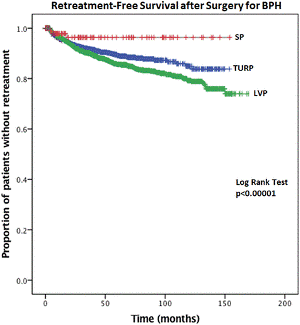Introduction and objectives:
Surgeries for benign prostatic hyperplasia (BPH) are commonly performed by urologists worldwide. Durability of these surgeries is reflected by the need for repeat endoscopic surgery. While clinical trials offer insight into short and intermediate-term reoperation in a controlled setting, long-term retreatment rates in the real world are not well characterized. This study compared reoperation rates following various surgical modalities for BPH treatment.
Methods:
A retrospective single health system database was used to identify patients undergoing a first-time surgery for BPH, including transurethral resection of the prostate (TURP), laser vaporization of the prostate (LVP), and simple prostatectomy (SP). The primary outcome was endoscopic reoperation at least 90 days after the index surgery.
Results:
A total 4,985 patients underwent BPH surgery between 2001-2016, including 2,304 (46.2%) TURP, 2,549 (51.1%) LVP, and 132 (2.7%) SP. Median follow-up was 26.5 (IQR 7.1-59.0) months. Overall, 419 (8.4%) patients required a subsequent endoscopic operation, occurring a median 19.5 (IQR 7.7-39.3) months after initial BPH surgery. Significant differences in reoperation rates existed across surgical modalities, with the highest reoperation rate after LVP (268/2549, 10.5%), followed by TURP (148/2304, 6.4%), and lowest rate of subsequent endoscopic surgery after SP (3/132, 2.3%) (p<0.0001). On Cox proportional hazards regression analysis adjusting for baseline demographic and clinical characteristics, primary BPH surgical modality was independently associated with subsequent endoscopic surgery (p=0.007). Compared to LVP (referent), TURP (hazard ratio [HR] 0.78, 95% confidence interval 0.64-0.95) and SP (HR 0.28, 0.09-0.87) were less likely to require secondary surgery (Figure 1).
Conclusions:
Variation exists in rates of subsequent endoscopic surgery following surgical treatment of BPH, suggesting specific approaches provide differing long-term durability. Reoperations reflect increased patient morbidity and greater healthcare resource utilization. Discrepant reoperation rates should be factored into the shared decision-making process for BPH management.
